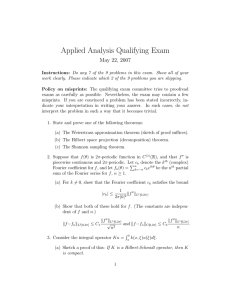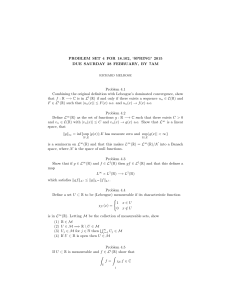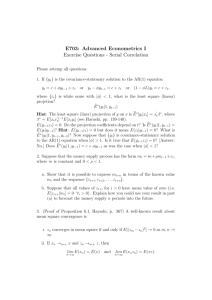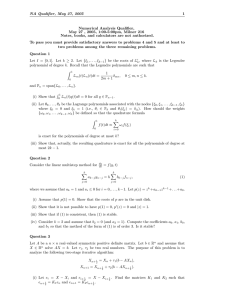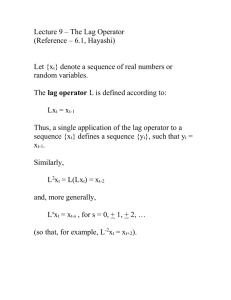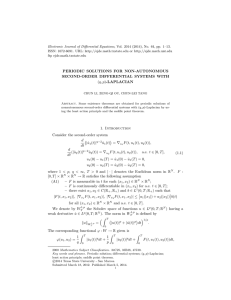LECTURE 5, 18.155, 22 SEPTEMBER 2011
advertisement
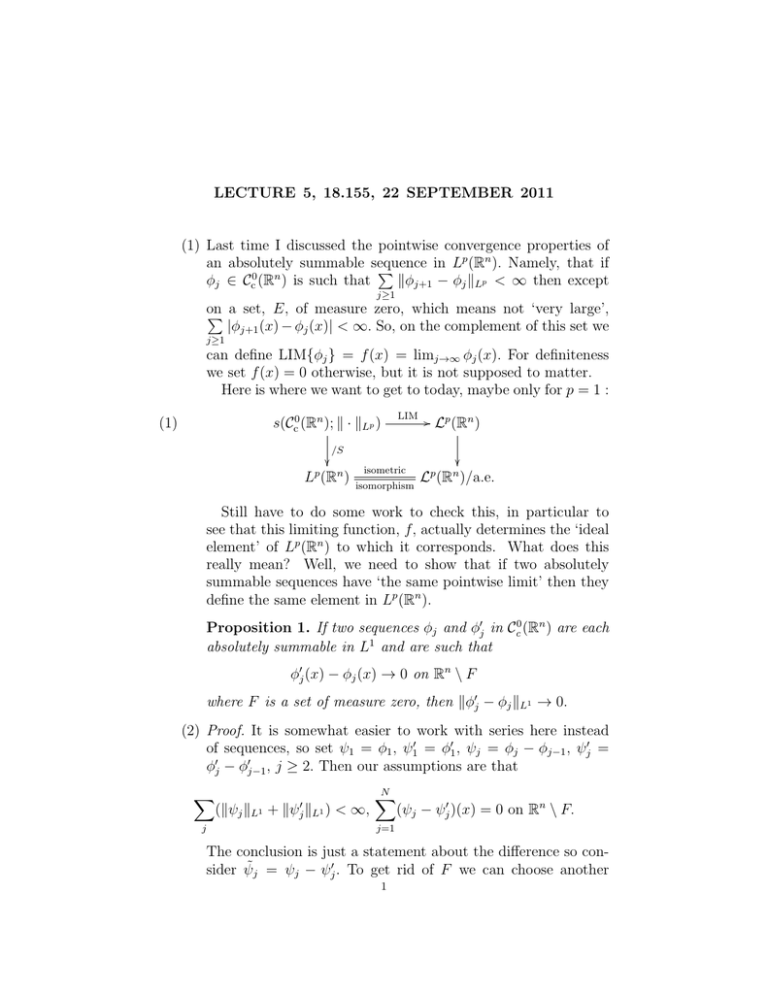
LECTURE 5, 18.155, 22 SEPTEMBER 2011
(1) Last time I discussed the pointwise convergence properties of
an absolutely summable sequence
in Lp (Rn ). Namely, that if
P
0
n
φj ∈ Cc (R ) is such that
kφj+1 − φj kLp < ∞ then except
j≥1
on
P a set, E, of measure zero, which means not ‘very large’,
|φj+1 (x) − φj (x)| < ∞. So, on the complement of this set we
j≥1
can define LIM{φj } = f (x) = limj→∞ φj (x). For definiteness
we set f (x) = 0 otherwise, but it is not supposed to matter.
Here is where we want to get to today, maybe only for p = 1 :
s(Cc0 (Rn ); k · kLp )
(1)
p
LIM
/
Lp (Rn )
/S
n
L (R )
isometric
isomorphism
p
n
L (R )/a.e.
Still have to do some work to check this, in particular to
see that this limiting function, f, actually determines the ‘ideal
element’ of Lp (Rn ) to which it corresponds. What does this
really mean? Well, we need to show that if two absolutely
summable sequences have ‘the same pointwise limit’ then they
define the same element in Lp (Rn ).
Proposition 1. If two sequences φj and φ0j in Cc0 (Rn ) are each
absolutely summable in L1 and are such that
φ0j (x) − φj (x) → 0 on Rn \ F
where F is a set of measure zero, then kφ0j − φj kL1 → 0.
(2) Proof. It is somewhat easier to work with series here instead
of sequences, so set ψ1 = φ1 , ψ10 = φ01 , ψj = φj − φj−1 , ψj0 =
φ0j − φ0j−1 , j ≥ 2. Then our assumptions are that
X
j
(kψj kL1 +
kψj0 kL1 )
< ∞,
N
X
(ψj − ψj0 )(x) = 0 on Rn \ F.
j=1
The conclusion is just a statement about the difference so consider ψ̃j = ψj − ψj0 . To get rid of F we can choose another
1
2
LECTURE 5, 18.155, 22 SEPTEMBER 2011
absolutely
summable (in L1 ) series ηj ∈ Cc∞ (Rn ) such that
P
|ηj (x)| = ∞ on F. Then consider the intertwined sequence
k
ψ̃k
µj = ηk
−η
k
if j = 3k − 2
if j = 3k − 1
if j = 3k.
for k ≥ 1. This is absolutely summable in L1 since all three
sequences are. Moreover
X
X
|µj (x)| < ∞ =⇒
|ηk (x)| < ∞
j
k
=⇒ x ∈ F
=⇒
X
µj (x) → 0 as N → ∞,
j<N
since the partial sums of this series alternate between
N
P
φ̃k (x))
k=1
(2)
and this plus µk (x) which tends to zero.
So, this is what we know, that
∞
X
X
|µj (x)| < ∞ =⇒
µj (x) = 0.
j
j=1
Now fix (a large) N and consider the difference
(3)
Φk (x) = |
X
j≤N
µj (x)| −
N
+k
X
|µj (x)|, x ∈ Rn .
j=N +1
As k increases, this is a decreasing sequence of continuous functions of compact support – since the sum subtracted is increasing in size. There are two cases – where the condition on the
left in (2) holds and when it doesn’t. If it holds then the limit
of Φk (x) as k → ∞ is negative, since the right side of (2) converges to zero. On the other hand if the condition in (2) does
not hold then Φk (x) → −∞.
So, if we put
Ψk (x) = (Φk (x))+
– just take the positive part – then Ψk (x) is a decreasing sequence of non-negative continuous functions which all vanish
outside a fixed compact set (any set outside which the first
vanishes) and which tends pointwise to 0.
LECTURE 5, 18.155, 22 SEPTEMBER 2011
3
One of the basic properties of compact spaces is that this
implies that Ψk → 0 uniformly. Indeed, take δ > 0 and look at
the sets
Kk = {x ∈ Rn ; Ψk (x) ≥ δ}.
By continuity these are closed and hence compact. By monotonicity they are decreasing, Kk+1 ⊂ Kk , and by pointwise convergence to 0 the total intersection in empty. It follows that
some finite intersection is empty and uniform convergence to
zero follows. Hence from the properties of Riemann integrals,
Z
Ψk (x) → 0
and so going back to Φk ≤ Ψk we conclude that
Z NX
Z X
+k
|µj (x)| ≤ 0.
µ| − lim
|
k→∞
j≤N
j=N +1
The limit here is finite by the absolute summability, so what we
have shown, by applying the triangle inequality, is that
X
X
k
µj (x)kL1 ≤
kµj kL1 .
j≤N
j>N
This however implies what we want, that
lim kφj − φ0j kL1 = 0.
N →∞
(3) Now, let us try to put things together a little in this case where
p = 1. Simply define
X
(4) L1 (Rn ) = f : Rn −→ C; ∃ φj ∈ Cc0 (Rn ),
kφj+1 − φj kL1 < ∞,
j
n
f (x) = lim φj (x) on R \ E for E of measure zero .
j→∞
We can call a sequence φj as given here an approximating sequence (of continuous functions) in L1 for f.
On this space the integral is well-defined:
(5)
Lemma 1. If f ∈ L1 (Rn ) then
Z
Z
f = lim φj
j
is independent of the choice of approximating sequence.
4
LECTURE 5, 18.155, 22 SEPTEMBER 2011
(4) Proof. If φj and φ0j are two approximating sequences for f in
the sense of (4) then we know that φj (x)−φ0j (x) → R0 off a set of
measure zero so Proposition (1) shows that limj→∞ |φj −φ0j | =
0. It follows that
Z
Z
Z
0
| φj − φj | ≤ |φj − φ0j | → 0
so the integral of f is well-defined.
(5)
Lemma 2. If f ∈ L1 (Rn ) then |f | ∈ L1 (Rn ).
Indeed, if φj is an approximating sequence for f then |φj | is
an approximating sequence (which is why I switched to continuous rather than smooth functions to avoid an approximation
argument here) for |f | – it converges to |f (x)| off a set of measure zero and is absolutely summable by the reverse triangle
inequality
Z
Z
||φj+1 (x)| − |φj (x)|| ≤ |φj+1 (x) − φj (x)|.
R
Thus |f | = kf kL1 is well-defined and is in fact a seminorm
on L1 (Rn ). (There are details to check here).
(6)
Theorem 1. The map sending an absolutely summable sequence
in Cc0 (Rn ) to its ‘limit’ given as the limit whenever the pointwise
sequence is absolutely summable and zero otherwise, projects to
an isometric isomorphism
L1 (Rn ) −→ L1 (Rn )/a.e.
where equality almost everywhere means taking the quotient with
respect to
Z
1
n
{f ∈ L (R ); |f | = 0} = {f ∈ L1 (Rn ); f = 0 a.e.}.
CAUTION: Before taking the quotients this – i.e. LIM in (1)
– is not a linear map.
(7) Proof. The one thing to check here is that the null space of the
seminorm on L1 (Rn ) consists precisely of those f which vanish
off a set of measure zero.
To see this we check what is really its ‘completeness’ with
respect to the seminorm. Thus, suppose that fj ∈ L1 (Rn ) is an
LECTURE 5, 18.155, 22 SEPTEMBER 2011
(6)
5
absolutely summable series with respect in the sense that
X
kfj kL1 < ∞.
j
Choose approximating sequences for each fj , φj,k . Then, for
each j, choose Nj so P
large that ψj,1 = φj,Nj +1 is such that kfj −
−j
ψj,1 kL1 < 2 , and
kψj,p kL1 ≤ 2−j where ψj,p = φj,Nj +p −
p>1
ψj,Nj +p−1 . This is possible
by the absolute summability and then
P
the double series
kψj,p kL1 is absolutely convergent – any fik,p
P
nite sum is bounded above
kfj kL1 + 2. So any (exhaustive)
j
ordering of this double sequence (such as the usual diagonal exhaustion) gives an absolutely
summable series in L1 . It follows
P
that the double series
|φj,p (x)| < ∞ off a set of measure zero
j,p
P
and hence that fj (x) < ∞ off a set of measure zero since this
j
P
is the sum of the absolutely convergent double series
ψj,p (x).
k,p
1
n
R So, suppose we have an element f ∈ L (R ) which satisfies
|f | = 0, where this integral is by definition the limit of an
approximating sequence. We can apply the discussion above
with fj = |f | for all j, since this satisfies (6). So, j|f (x)| → 0
off a set of measure zero, which means that f (x) = 0 off a set
of measure zero!
So, this establishes that S, defined as the null space of the
seminorm consists precisely of the subset of L1 (Rn ) of elements
vanishing almost everywhere. Everything is now pretty straightforward. The projected map from absolutely summable sequences to L1 (Rn )/a.e. can be seen to be linear by adding approximating sequences, to be surjective essentially by definition
(and of course the existence of the limiting f ’s) and to have null
space precisely S by what we have just shown.
(8) What about the case p > 1? We can just proceed in the same
way, defining
X
Lp (Rn ) = f : Rn −→ C; ∃ φj ∈ Cc∞ (Rn ),
kφj+1 − φj kLp < ∞,
j
n
f (x) = lim φj (x) on R \ E for E of measure zero .
j→∞
Now, if f ∈ Lp (Rn ) it follows that |f |p ∈ L1 (Rn ) and then
R
1
we can define the seminorm kf kLp = ( |f |p ) p . Indeed, if φj is
6
LECTURE 5, 18.155, 22 SEPTEMBER 2011
an approximating sequence with respect to the Lp norm, then
ψj = |φj (x)|p → |f (x)|p almost everywhere. In fact, the ψj form
an absolutely summable sequence in L1 since
Z
kψj+1 − ψj kL1 = ||ψj+1 |p − |ψj |p |
Z
≤ C (|ψj+1 |p−1 + kψj |p−1 )|ψj+1 | − |ψj ||
p/q
≤ C 0 (sup kψj kLp kψj+1 − ψj kLp .
j
The null space of this is again precisely the space of functions in L1 (Rn ) which vanish off a set of measure zero and then
Lp (Rn )/S is a concrete completion of Cc∞ (Rn ) with respect to
the Lp norm.
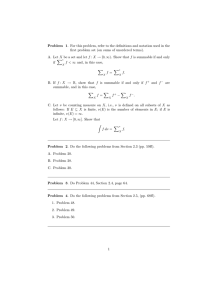
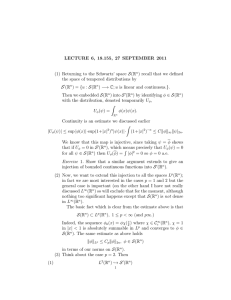
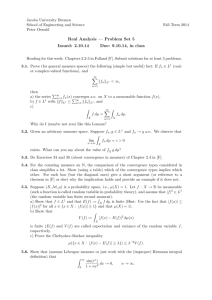

![MA342A (Harmonic Analysis 1) Tutorial sheet 8 [December 10, 2015] Name: Solutions √](http://s2.studylib.net/store/data/010415901_1-00035e0c3b9d31c812df276d6fe8c92d-300x300.png)
